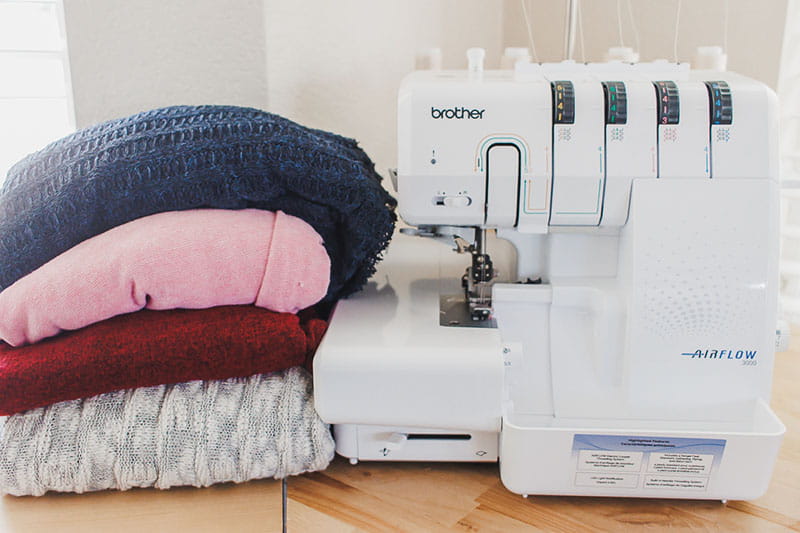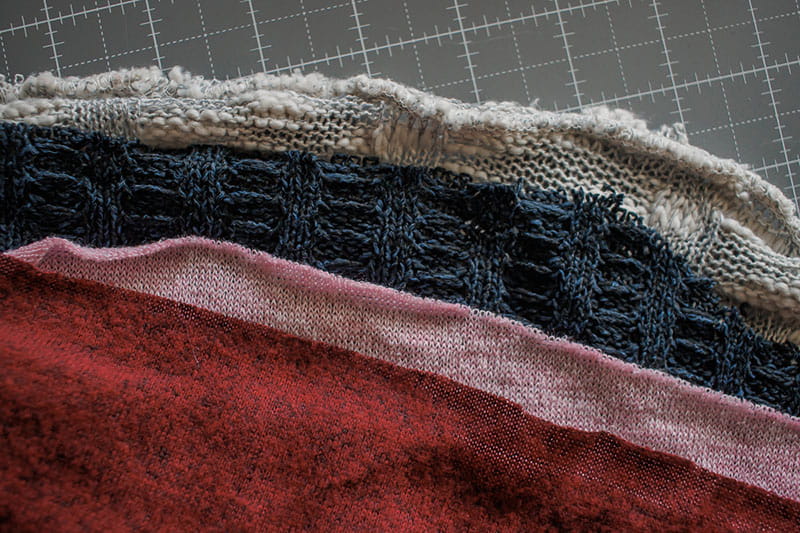Sewing with Sweater Knits
Learn how easy it is to sew cozy sweaters with the Airflow3000. This article gives five tips for getting started sewing with sweater knit fabric. Be cozy and comfy this winter.
Tools and Supplies
- AIRFLOW3000 (or other Brother Serger)
- Sweater knit fabric
- Coordinating thread for serger
- Pattern for sewing (Hat, mittens, sweater, etc.)

I love sewing with sweater knits! You can create gorgeous sweaters for fall or winter with your Brother Serger. I recently sewed myself a sew sweater and while I did I recorded my top five tips for sewing with sweater knits. Before we get into the actual sewing, let’s take a look at some of the variations of sweater knits.

Sweater knits range from thin/tight weaves (very close to regular knit fabric), to thick/chunky/loose weaves that are a bit harder to sew, but with a serger you can easily sew up something amazing with whatever fabric you choose to sew.
Tip #1
Use a matching thread. With loose weave sweater knits, the seams are more likely to show through your fabric. With the Airflow3000, changing thread is a breeze and takes just a few minutes. I used to only change my serger thread when absolutely necessary, but now I don’t mind at all.


This cream thread blends right in with the multi colored sweater knit I was using for my sweater. With the loose weave you can see how important having the right color thread can be. With matching thread, even if it does show through on the seams, it all blends together.

Tip #2
Start basic! If you have never sewn with sweater knits before I would suggest starting with thinner/tighter weave fabric. This sews more like regular fabric and is a great place to start. All the other tips below can still apply to this type of sweater knit, but this kind is really easier to sew. You can also start with a more simple project, hats, mittens, scarves… before moving onto clothing.



Tip #3
Use a wider than normal seam allowance. With thick, chunky, loose weave fabric you want to make sure you really grab all the fibers with your machine. The best way to do this is by using a wide seam allowance. I normally like to sew with a ¼” seam allowance on my serger, but I use at least a ½” seam allowance with sweater knit fabrics. This gives me the strongest, most secure seam possible when sewing with a loose weave fabric.


Tip #4
Adjust the differential feed on your machine. Especially with thick, stretchy fabrics, there is a tendency to get some waves in your seams when sewing on a serger. This is easily fixed by raising the number on your differential feed dial. The normal setting is 1.0 and I move it anywhere between the 1 and the 2 depending on my fabric.

The difference in the seams is easy to see. You also can “help” your feed dogs by slightly pushing the fabric under the presser foot. This will keep any stretching to a minimum and give you beautiful flat seams. Practice with a scrap of your intended fabric before sewing any seams on the project.

Look at this beautiful, flat shoulder and arm seam? When you adjust the differential feed before sewing you can avoid having to try and press out wavy seams later.

Tip #5
Use a wider stitch width. This goes along with the wide seam allowance, but a wider stitch width really helps to secure the seams. You may already sew with a wider width, but I keep my serger set on 5 (personal preference), and I bump it up to a 6.5 width when sewing looser weave fabrics.


Sewing with a wider stitch is all part of getting the most secure seam possible. Even with chunky, loose fabrics.

When all of these tips are put together you can confidently sew even the most challenging sweater knits to create beautiful, cozy sweaters for yourself or family this fall.



I adore my cozy new sweater and look forward to wearing it many times this winter.
NOTE: I also wash and dry this as normal. No special care is needed if you prewash the fabric. (unless using wool sweater knit)


